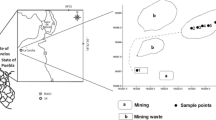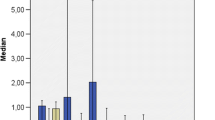Abstract
Some wetland plant species are adapted to growing in the areas of higher metal concentrations. Use of such vegetation in remediation of soil and water contaminated with heavy metals is a promising cost-effective alternative to the more established treatment methods. Throughout the year, composite industrial effluents bringing various kinds of heavy metals contaminate our study site, the East Calcutta Wetlands, a Ramsar site at the eastern fringe of Kolkata city (formerly Calcutta), India. In the present study, possible measures for remediation of contaminated soil and water (with elements namely, Ca, Cr, Cu, Pb, Zn, Mn, and Fe) of the ecosystem had been investigated. Ten common regional wetland plant species were selected to study their efficiency and diversity in metal uptake and accumulation. Results showed that Bermuda grass (Cynodon dactylon) had the highest total Cr concentration (6,601 ± 33 mg kg − 1 dw). The extent of accumulation of various elements in ten common wetland plants of the study sites was: Pb (4.4–57 mg kg − 1 dw), Cu (6.2–39 mg kg − 1 dw), Zn (59–364 mg kg − 1 dw), Mn (87–376 mg kg − 1 dw), Fe (188–8,625 mg kg − 1 dw), Ca (969–3,756 mg kg − 1 dw), and Cr (27–660 mg kg − 1 dw) indicating an uptake gradient of elements by plants as Ca>Fe>Mn>Cr>Zn>Cu>Pb. The present study indicates the importance of identification and efficiency of metal uptake and accumulation capabilities by plants in relation to their applications in remediation of a contaminated East Calcutta Wetland ecosystem.
Similar content being viewed by others
References
Alam, S., Kodama, R., Akiha, F., Kamei, S. & Kawai, S (2006). Alleviation of manganese phytotoxicity in barley with calcium. Journal of Plant Nutrition, 29(1), 59–74.
Banks, M. K., Schwab, A. P., & Henderson, C. (2006). Leaching and reduction of chromium in soil as affected by soil organic content and plants. Chemosphere, 62, 255–264.
Bertrand, M., & Poirier, I. (2005). Photosynthetic organisms and excess of metals. Photosynthetica, 43(3), 345–353.
Birge, W., Price, W. J., Shaw, J. R., Spromberg, J. A., Wiggington, A. J., & Hogstrand, C. (2000). Metal body burden and biological sensors as ecological indicators. Environmental Toxicology and Chemistry, 19, 1199–1212.
Burton, K. W., Morgan, E., & Roig, A. (1984). The influence of heavy metals on the growth of Sitka-spruce in South Wales forests. II green house experiments. Plant Soil, 78, 271–282.
Chandra, P., Sinha, S., & Rai, U. N. (1997). Bioremediation of Cr from water and soil by vascular aquatic plants. In E. L. Kruger, T. A. Anderson, & J. R. Coats (Eds.), Phytoremediation of soil and water contaminants. ACS Symposium Series #664 (pp. 274–282). Washington, DC: American Chemical Society.
Chatterjee, S., Chattopadhyay, B., Chakraborty, A., Jal, P. K., Sudarshan, M., & Mukhopadhyay, S. K. (2005). Sequestration of waste metals from industries within East Calcutta Wetland ecosystem. Chemical and Environmental Research, 14(1–2), 79–88.
Chatterjee, S., Chattopadhyay, B., Dutta, S., & Mulhopadhyay, S. K. (2004). Possibility of heavy metal remediation in East Calcutta Wetland ecosystem using selected plant species. Journal of Indian Leather Technologist’s Association, LIV(4), 299–311.
Chatterjee, S., Chattopadhyay, B., & Mukhopadhyay, S. K. (2006). Heavy metal distribution in tissues of cichlids (Oreochromis niloticus and O. mossambicus) collected from wastewater-fed fishponds in East Calcutta Wetlands, a Ramsar Site. Acta Ichthyologica et Piscatoria, 36(2), 119–125.
Chatterjee, S., Chattopadhyay, B., & Mukhopadhyay, S. K. (2009). Monitoring waste metal pollution at ganga estuary via the East Calcutta Wetland areas. Environmental Monitoring and Assessment. doi:10.1007/s10661-009-1211-3.
Chatterjee, S., Chattopadhyay, B., Mulhopadhyay, S. K., Mohanta, B., Sudarshan, M., & Chakraborty, A. (2007). East Calcutta Wetlands as a sink of industrial heavy metals: A PIXE study. International Journal of PIXE, 17(3–4), 129–142.
Chattopadhyay, B., Chatterjee, A., & Mukhopadhyay, S. K. (2002). Bioaccumulation of metals in the East Calcutta Wetland ecosystem. Aquatic Ecosystem Health and Management, 5(2), 191–203.
Chattopadhyay, B., Gupta, R., Chatterjee, A., & Mukhopadhyay, S. K. (1999). Characterization of tannery effluents envisaging environmental impact assessment. Journal of American Leather Chemists’ Association, 94(9), 338–347.
Cheng, S. (2003). Heavy metals in plants and phytoremediation. Environmental Science and Pollution Research, 10(5), 335–340.
Clarkson, T. W. (1993). Molecular and ionic mimicry of toxic metals. Annual Review of Pharmacology and Toxicology, 33, 547–571.
Cobbett, C. S. (2000). Phytochelatin biosynthesis and function in heavy metal detoxification. Current Opinion in Plant Biology, 3, 211–216.
Eaton, A. D., Clesceri, L. S., & Greenberg, A. E. (1995). Standard methods of the examination of water and wastewater (19th ed.). Washington DC: APHA.
Eisler, R. (1986). Chromium hazards to fish, wildlife and invertebrates: A synoptic review. U.S. Fish and Wildlife Service Biological Report, 85(1.6), 60.
Espinoza-Quiñones, F. R., Rizzutto, M. A., Added, N., Tabacniks, M. H., Módenes, A. N., Palácio, S. M., et al. (2009). PIXE analysis of chromium phytoaccumulation by the aquatic macrophytes Eicchornia crassipes. Nuclear Instruments and Methods in Physics Research Section B: Beam Interactions with Materials and Atom, 267(7), 1153–1157.
Garbisu, C., Hernandez-Allica, J., Barrutia, O., Alkortaand, I., & Becerril, J. M. (2002). Phytoremediation: A technology using green plants to remove contaminants from polluted areas. Review on Environmental Health, 17(3), 173–188.
Ghosh, D. (1991). Sustainable development or real estate takeover? A Report. WWF, Calcutta.
Gupta, G. C. (1980). Use of water hyacinth in wastewater treatment (a brief literature review). Journal of Environmental Health, 43(2), 80–82.
Hall, J. L. (2002). Cellular mechanisms for heavy metal detoxification and tolerance. Journal of Experimental Botany, 53(366), 1–11.
Hanikenne, M., Talke, I. N., Haydon, M. J., Lanz, C., Nolte, A., Motte, P., et al. (2008). Evolution of metal hyperaccumulation required cis-regulatory changes and triplication of HMA4. Nature, 453, 391–395.
Hering, J. G., & Kraemer, S. (1998). Environmental chemistry of trace-metals. In D. L. Macalady (Ed.), Perspectives in environmental chemistry (pp. 57–74). NY: Oxford University Press.
Isaac, R. A., & Kerber, J. D. (1971). Atomic absorption and flame photometry: Techniques and uses in soil and plant and water analysis. In: L. M. Walsh (Ed.), Instrumental methods for analysis of soils and plant tissue (pp. 125). Madison: Soil Science Society of America.
Lasat, M. M. (2000). Phytoextraction of metals from contaminated soil: A review plant/soil/metal interaction and assessment of pertinent agronomic issues. Journal of Hazardous Substances Research, II, 5.1–5.25.
Lidon, F. C., & Henriques, F. S. (1992). Copper toxicity in rice: Diagnostic criteria and effect on tissue Mn and Fe. Soil Science, 154, 130–135.
Lombi, E., Zhao, F. J., Dunham, S. J., & McGrath, S. P. (2001). Phytoremediation of heavymetal-contaminated soils: Natural hyperaccumulation versus chemically enhanced phytoextraction. Journal of Environmental Quality, 30(6), 1919–1926.
Lu, X., Kruatrachue, M., Pokethitiyook, P., & Homyok, K. (2004). Removal of cadmium and zinc by water hyacinth, Eichhornia crassipes. Science Asia, 30, 93–103.
Mander, Ü., & Mitsch, W. J. (2009). Pollution control by wetlands. Ecological Engineering, 35(2), 153–158.
Markert, B., Gernot, K., Siegfried, K., & Oehlmann, J. (2000). Distribution and effect of trace substances in soil, plant and animals. In: B. Markert & K. Friese (Eds.), Trace elements—Their distribution and effects in the environment (pp. 3–31). Oxford: Elsevier.
Marschner, H. (1995). Mineral nutrition for higher plants (2nd ed.). Academic Press and Harcourt Brace & Co., Publishers London-San Diego-New York-Boston- Sydney-Tokyo-Toronto.
McIntyre, T. (2003). Phytoremediation of heavy metals from soils. Advances in Biochemical Engineering and Biotechnology, 78, 97–123.
Memon, A. R., Aktoprakligil, D., Ozdemir, A., & Vertii, A. (2001). Heavy metal accumulation and detoxification mechanisms in plants. Turkish Journal of Botany, 25, 111–121.
Mengel, K., & Kirkby, E. A. (1987). Principles of plant nutrition (4th ed.). Bern, Switzerland: International Potash Institute
Prasad, M. N. V., & Freitas, H. M. D. O. (1999). Feasible biotechnological and bioremediation strategies for serpentine soils and mine spoils. Electronic Jornal of Biotechnology, 2(1), 22–34.
Robinson, N. J., Tommey, A. M., Kuske, C. & Jackson, P. J. (1993). Plant metallothioneins. Biochemical Journal, 295, 1–10.
Sanders, D., Pelloux, J., Brownlee, C., & Harper, J. F. (2002). Calcium at the crossroads of signaling. Plant Cell, 14, S401–S417.
Schwab, A. P., Yinghong, H. E., & Banks, M. K. (2005). The influence of organic ligands on the retention of lead in soil. Chemosphere, 61, 856–866.
Singh, O. V., Labana, S., Pandey, G., Budhiraja, R., & Jain, R. K. (2003). Phytoremediation: an overview of metallic ion decontamination from soil. Applied Microbiology and Biotechnology, 61(5–6), 405–412.
Soltan, M. E., & Rashed, M. N. (2003). Laboratory study on the survival of water hyacinth under several conditions of heavy metal concentrations. Advances in Environmental Research, 7(2), 82–91.
Sunda, W. G., & Huntsman, S. A. (1983). Effect of competitive interaction between manganese and copper on cellular manganese and growth in estuarine and oceanic species of the diatom Thalassiosira. Limnology and Oceanography, 28, 923–924.
Vesk, P. A., Nockold, C. E., & Allaway, W. G. (1999). Metal localization in water hyacinth roots from an urban wetland. Plant Cell and Environment, 22, 149–158.
Welz, B., & Sperling, M. (1999). Atomic absorption spectrometry. Wiley-VCH: Weinheim.
Author information
Authors and Affiliations
Corresponding author
Rights and permissions
About this article
Cite this article
Chatterjee, S., Chetia, M., Singh, L. et al. A study on the phytoaccumulation of waste elements in wetland plants of a Ramsar site in India. Environ Monit Assess 178, 361–371 (2011). https://doi.org/10.1007/s10661-010-1695-x
Received:
Accepted:
Published:
Issue Date:
DOI: https://doi.org/10.1007/s10661-010-1695-x




